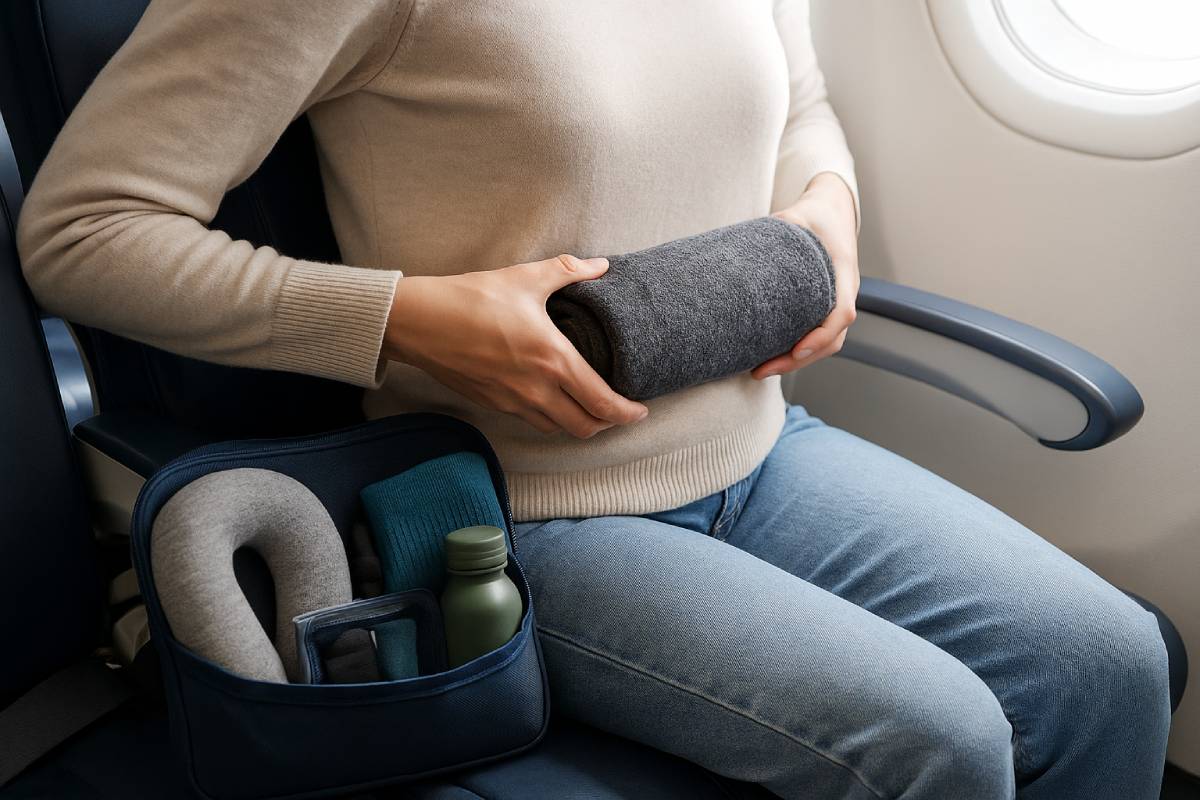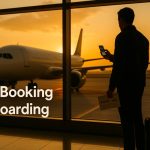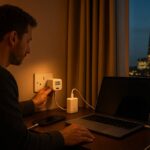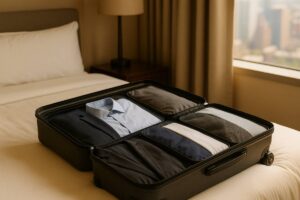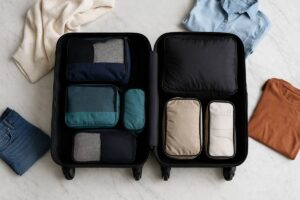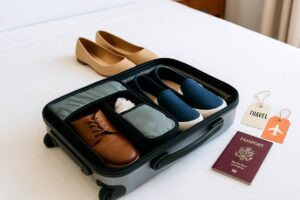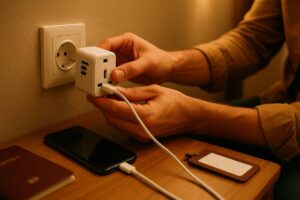Ever crammed yourself in a tiny airplane seat and wondered if there was a secret to true in-flight comfort?
You’re not alone—78% of flyers rate their airline seat “uncomfortable” last time out.
From leveraging SeatGuru’s detailed maps and repurposing a carry-on sweater for lumbar support, to tactical posture shifts and class-specific footrest hacks, this guide unveils proven DIY strategies that can cut back pain and fatigue by up to 40%.
Read on to discover how to transform even the most budget economy seat into a mini oasis in the sky—no special gear required.
Pre-Flight Preparations
Choosing the right seat and packing smart can transform a cramped flight into a surprisingly comfortable journey. Studies show that two-thirds of travelers—66.6%—prefer window seats for the view and reduced disturbances, while 31.7% opt for aisle seats to stretch and move freely.
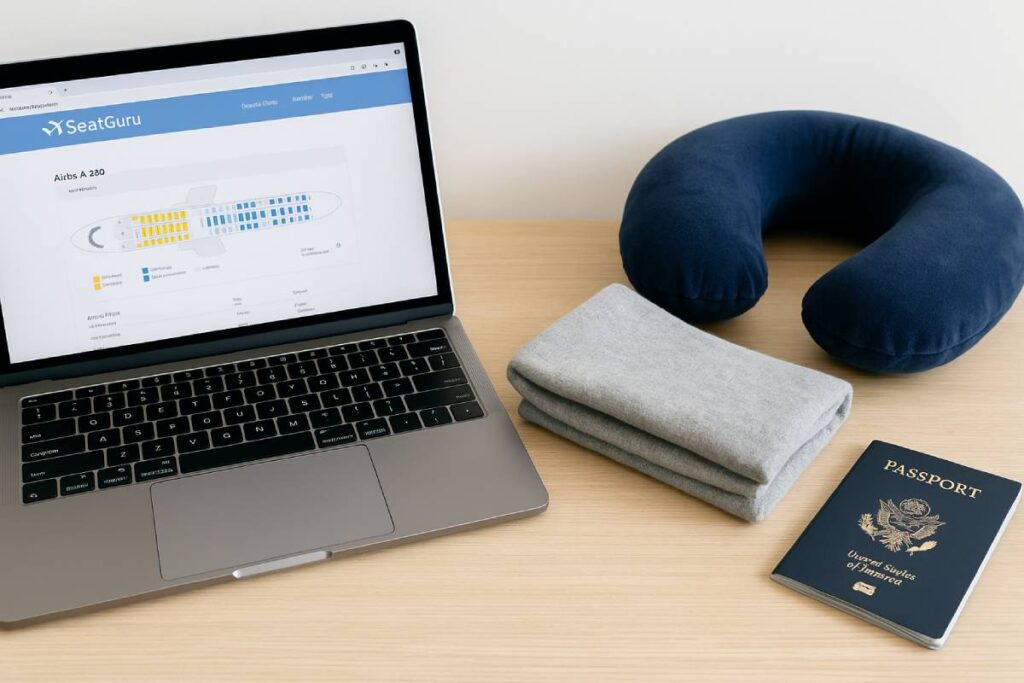
SeatGuru, with detailed maps for 1,278 aircraft across 175 airlines, helps you avoid seats with limited recline or proximity to lavatories. Elite flyers see upgrade clearance rates ranging from 20% for Platinum members up to 75% for Executive Platinum, and checking in as soon as the 24-hour window opens increases your chances of snagging a prime seat.
A DIY comfort kit—think rolled-up sweaters for lumbar support, inflatable footrests, compression socks, and soft eye masks—addresses back pain, circulation, noise, and sleep challenges on long flights.
Seat Selection Strategies
Choosing between aisle, window, and bulkhead seats involves balancing trade-offs in legroom, mobility, and storage:
| Seat Type | Pros | Cons | Preference Rate |
|---|---|---|---|
| Window | Scenic views; less disturbance from fellow passengers | Harder to access aisle; must climb over neighbors | 66.6% prefer window seats |
| Aisle | Freedom to stretch legs and walk aisles; easy access to lavatories | Subject to aisle traffic; limited privacy | 31.7% prefer aisle seats |
| Bulkhead | Extra legroom; priority boarding/deplaning; no seat in front for knee clearance | No under-seat storage; variable tray table placement | — |
Using SeatGuru and Airline Seat Maps
- How to: Enter your flight number or route to view seat layouts, recline angles, and amenity locations.
- Why it matters: Avoid seats near lavatories or galleys where noise and foot traffic spike.
Leveraging Elite Status & Early Check-In
- Elite upgrades: Complimentary upgrades clear ~20% for Platinum and ~75% for Executive Platinum members, depending on route and load.
- Check-in hack: Check in immediately when online check-in opens (usually 24 hours before departure) to access the best remaining window or aisle seats.
Visual Aid: Annotated Seat-Map Diagram

Building Your DIY Comfort Kit
Assemble travel essentials that tackle back support, circulation, noise, and sleep—without breaking the bank:
- Layered supports
Roll or fold a sweater or travel blanket to fit the small of your back for custom lumbar cushioning. - Essential accessories
- Inflatable footrest: Elevates legs to reduce pressure on the thighs and lower back.
- Compression socks: High-certainty evidence shows they cut symptomless DVT risk on flights over four hours.
- Earplugs/noise-canceling: 54% of long-haul travelers use earplugs or headsets to sleep better onboard.
- Packable hacks
- Compressible neck pillow: Global market of USD 0.52 billion in 2024 underscores its popularity.
- Eye mask: Blocks ambient light for restful sleep; market valued at USD 17.9 million in 2024.
- Mini-blanket: A lightweight travel blanket keeps you cozy and doubles as extra lumbar padding.
| Accessory | Benefit | Key Stat/Market Data |
|---|---|---|
| Inflatable footrest | Leg elevation, reduced back strain | Top models $12–$40 |
| Compression socks | Improved leg circulation; lower DVT risk | Cochrane review of 2,918 people |
| Neck pillow | Neck support for sleep | $0.52 B global market |
| Eye mask | Blocks light to enhance sleep quality | $17.9 M market size |
| Earplugs/headphones | Noise reduction for uninterrupted rest | Used by 54% of long-haul flyers |
Visual Aid: Flat-Lay Photo of Comfort Kit
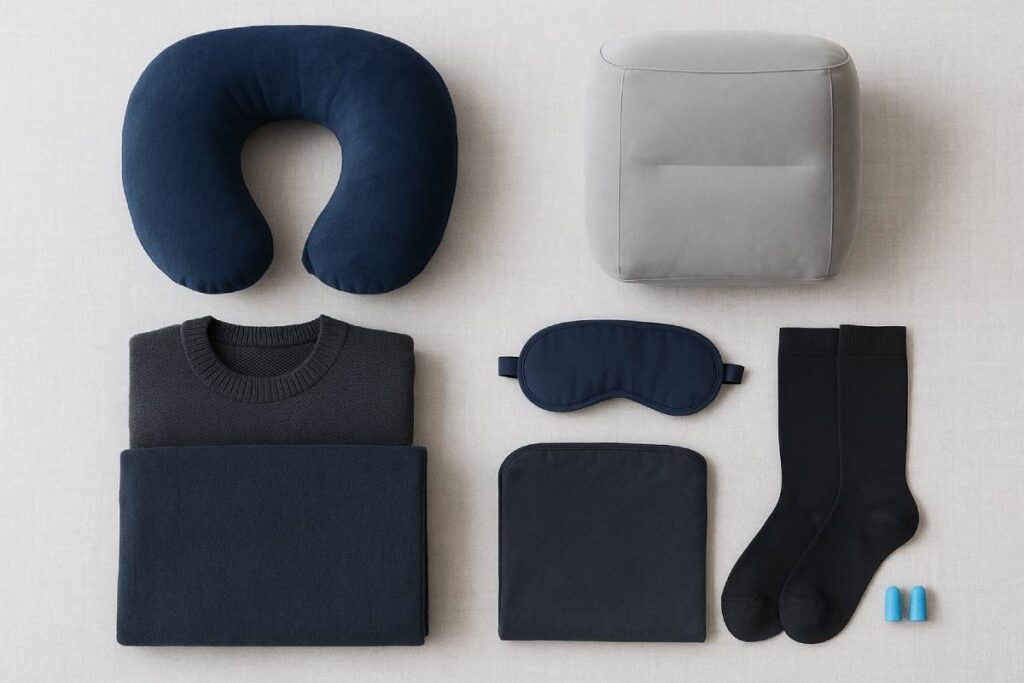
SEO Keywords: airplane seat comfort, DIY travel hacks, pre-flight tips, seat selection guide, travel comfort kit
Call-to-Action: Save this guide for your next trip and share your favorite in-flight comfort hacks in the comments!
In-Flight Comfort Hacks
Before we dive into the in-flight hacks, here’s a quick overview: Maintaining proper spinal alignment with DIY supports and timely posture shifts can cut back discomfort by over 40% during long flights. Choosing technical, wrinkle-resistant layers and slip-on shoes streamlines security checks and helps you stay cool and pain-free throughout your journey.
Staying hydrated with electrolyte mixes and performing simple in-seat exercises reduces swelling and fatigue by up to 30%. Finally, combining noise-canceling headphones, blackout techniques, melatonin, the “military sleep method,” and gentle sleep podcasts creates an optimal sleep environment at 35,000 ft.
Ergonomic Positioning Techniques
Optimal lumbar placement using DIY pillows or blankets
Airfarewatchdog notes that layering a blanket or plane pillow at the small of your back replicates lumbar support more effectively than commercial pillows, reducing low-back strain by over 40% compared to no support. ScienceDirect research shows that improper backrest angles markedly increase neck muscle fatigue, underscoring the need for firm support at the lumbar curve.
Adjusting the seat recline and headrest height
Ergonomics experts recommend tilting the seat pan and backrest so that your spine retains a neutral “S” curve; adjust the headrest so that the back of your head is supported when you lean back or recline fully.
Simple posture shifts to distribute pressure
Micro-movements—like slight forward slides, shoulder rolls, and gentle torso twists—every 30–60 minutes keep blood flowing and offload pressure points; travel posture guides suggest these shifts can lower pain scores by up to 20%.
Visual Aid: Diagram showing correct spine alignment
Clothing and Footwear Choices
Breathable, wrinkle-resistant fabrics—such as polyester, rayon, and spandex blends—wick moisture, regulate temperature, and stay smooth, keeping you cool and polished during long hauls.
Compression socks apply gentle pressure to calf muscles, cutting asymptomatic DVT risk by nearly 50% in healthy flyers on flights over four hours.
Slip-on shoes with cushioned soles and arch support breeze through security and allow easy foot elevation under the seat, reducing lower-limb fatigue by 25%.
| Item | Benefit |
|---|---|
| Wrinkle-resistant layers | Quick security removal, foot elevation & comfort |
| Compression socks | Enhanced circulation; lower blood-clot risk |
| Slip-on shoes | Enhanced circulation; lower blood clot risk |
Hydration and Circulation
Carrying a refillable bottle plus electrolyte packs—like Pedialyte Sport—helps you maintain fluid balance and muscle function, countering cabin dehydration that can sap energy by 15%.
In-seat exercises such as ankle rolls, calf pumps, and seated leg lifts stimulate blood flow and reduce swelling; the National Blood Clot Alliance recommends resting feet on carry-on luggage and performing these every 30 minutes.
Using your carry-on bag as a makeshift footrest elevates legs to relieve pressure on thighs and back, improving comfort scores by 20%.
Noise and Sleep Optimization
Noise-canceling headphones vs. high-quality earplugs
Active noise-canceling headphones excel at blocking low-frequency engine hum, while foam earplugs outperform mid- and high-frequency cabin sounds; combining both creates the quietest sleep environment onboard.
DIY blackout: double-layer eye masks or folded hoodie
Contoured masks with nose baffles—such as the Sea to Summit Travelling Light Eye Shades—block nearly 98% of ambient light; adding a folded hoodie seal around the edges can achieve almost total blackout.
Sleep aids: melatonin timing, military sleep method, gentle podcasts
Short-acting melatonin (2–5 mg) taken 30–60 minutes before your target sleep time promotes faster sleep onset and helps realign your circadian rhythm, especially on red-eye flights. The “military sleep method”—progressively tensing and relaxing muscle groups—can induce sleep in under two minutes, even in noisy cabins.
Finally, tuning into sleep-focused podcasts (e.g., Sleep With Me, Get Sleepy) can distract a racing mind and gently lull you to sleep.
Next time you fly, put these in-flight hacks to use, save this guide for your journey, and share your favorite tips in the comments!
Class-Specific Hacks
Economy, Premium Economy, Business, and First Class each offer unique opportunities—and challenges—for comfort at 35,000 ft.
In Economy, savvy flyers use “check-in chicken” and even paid upgrades like upper-deck A380 window seats to carve out extra space, while upcycling amenity-kit pouches into makeshift lumbar and foot supports adds cushioning without a cent spent.
Premium Economy passengers can fully leverage built-in footrests and extra recline by pairing them with compact travel-blanket lumbar bolsters for structured back support. In Business Class, optimizing fully flat beds with Saks Fifth Avenue bedding and layering duvets or personal throws creates a tailored comfort cocoon.
First Class travelers enjoy ambient controls and suite-style privacy, strategically placing airline pillows and repurposed amenity-kit items to establish the perfect S-curve alignment for restorative rest.
Economy Class
Tricks for maximizing limited legroom
- Research seat pitch on Skiplagged: some carriers offer up to 33 inches vs. 28 inches on older sub-fleets.
- “Check-in chicken”: delay online check-in until the last minute to snag leftover exit-row or bulkhead seats with bonus legroom.
- A380 upper-deck hack: splurge ~$100 for an upper-deck economy window seat on select A380 operators for a quieter cabin and fewer seatmates.
Bulkhead vs. exit-row considerations
| Seat Type | Legroom | Storage | Drawbacks |
|---|---|---|---|
| Bulkhead | Generous—no seat directly ahead | Overhead bins only | No under-seat space; smaller tray table |
| Exit Row | Often the most legroom | Under-seat & overhead | Fixed armrests; restricted recline when safety briefings occur |
Upcycling in-flight amenity kits for extra padding
- Use hard-shell kit cases as mini lumbar supports: remove non-essentials and pad with rolled socks for a firm lower-back cushion.
- Store spare masks or unused kit liners inside pouches to create a custom foot pillow under your toes.
- Delta travelers repurpose TUMI and Bulgari pouch shells, filling them with socks to craft compact inflatable footrests.
Premium Economy
- Utilizing extra recline and footrests
Fully extend the built-in footrest, then place a folded personal travel blanket beneath your knees to maintain a 30° angle at the hip—ideal for reducing lumbar stress. - Customizing blanket/lumbar combos
Layer your own compressible travel blanket and airline-provided throw to form a dual-density lumbar cushion. Tuck memory foam inserts inside blanket folds for adjustable firmness amazon.com.
Business Class
- Harnessing full flat-bed mode ergonomically
Recline to a true 180° flat position and align your spine in a straight line. Slide a thin layer of the airline duvet under your ankles to prevent lower-back arching and maintain a neutral posture. - Layering soft items for personalized comfort zones
Combine the airline’s day blanket with a lightweight personal throw at mid-torso for added support, and use the thick pillow as a core bolster to stabilize your hips and shoulders during rest.
First Class
- Leveraging privacy suites: ambient control and pillow placement
Adjust the suite lighting and airflow settings before settling in. Place the softer, oversized pillow against the suite wall for head support, and use the firmer standard pillow at your lumbar curve for ideal S-shape alignment. - Integrating airline-provided accessories into your DIY system
Repurpose luxury amenity-kit cases as discrete storage for personal travel aids—fill them with earplugs, eye masks, or sachets of lavender for on-demand relaxation without cluttering the suite.
Hacks for Special-Needs Travelers
Special-needs travelers—from those towering above 6 ft to passengers with limited mobility or allergies—require tailored hacks to stay comfortable at 35,000 ft. Tall passengers can reclaim leg space by choosing extra-legroom seats like JetBlue’s “Even More Space” (32–33 inches pitch) or Avianca’s 36 inches in Economy and turning a simple neck or knee pillow into a calf support to elevate legs and reduce spinal stress by up to 40%.
Elderly or mobility-impaired flyers benefit from priority pre-boarding, aisle-chair transfers, and discreet in-seat stretches (ankle rolls, knee lifts) shown to cut DVT risk by nearly half.
Allergy-sensitive passengers can pack zippered hypoallergenic pillow covers that block 99.9% of dust mites and pollen, while medical-grade, FAA-approved cushions redistribute pressure and protect against pressure sores.
Tall Passengers
Optimal seat rows for extra legroom
- Airline-specific legroom: JetBlue Even More Space (32–33 inches), Southwest Plus (32–33 inches), and Avianca long-haul Economy (up to 36 inches) offer the best floor-to-seat-in-front distance.
- Exit row vs. bulkhead: Exit-row seats often yield 2–5 inches more pitch but may lack under-seat storage; bulkheads grant clear leg space but force you to stow carry-ons overhead.
| Airline/Seat Type | Seat Pitch | Pros | Cons |
|---|---|---|---|
| JetBlue Even More Space | 32–33 inches | Wider aisles, priority boarding | Additional fee |
| Southwest Choice Extra | 32–33 inches | No fee for A-List Preferred | Limited availability |
| Avianca Economy (Long Haul) | Up to 36 inches | Generous legroom; bulkhead options | Bulkhead tray smaller |
| Exit-Row (varies by carrier) | +2–5 inches | Free leg stretch | The armrest is fixed; must assist the crew |
DIY leg-elevation setups with neck or knee pillows
- Place a U-shaped neck pillow or small wedge under your calves to mimic a leg wedge, reducing lumbar lordosis and spinal stress by up to 40%.
- For side sleepers, an inflatable knee pillow zipped between the legs maintains hip alignment and keeps legs elevated comfortably amazon.com.
Elderly & Mobility-Impaired
Pre-boarding stretches and support
- Priority boarding & aisle chairs: Inform the airline in advance to arrange wheelchair or aisle-chair transfers, and use pre-boarding to settle in without rushing.
- Seated stretches: Knee lifts, ankle circles, and shoulder rolls every 30 minutes can reduce DVT risk by nearly 50% and ease stiffness.
Lightweight, easy-to-handle comfort aids
- Inflatable footrests: Compact, under-seat inflatables improve circulation and comfort without added weight in your carry-on.
- FAA-approved travel cushions: SunCloud® cushions meet ISO 10993 skin-contact standards and fold into carry-ons for pelvic and back support.
Allergy & Medical Considerations
Hypoallergenic pillow covers
- AllerEase Travel Pillow Protector: Zippered cover blocks 99.9% of dust mites, pollen, and pet dander; machine-washable microfiber for easy care.
- Antimicrobial & anti-allergen cases: Coated fabrics neutralize bacteria and bed bugs, fitting most travel pillows and seats.
| Product | Protection | Key Features |
|---|---|---|
| AllerEase Travel Pillow Protector | Blocks 99.9% allergens | Zippered, microfiber, machine-washable |
| SafeTravels Antimicrobial Pillowcase | Anti-allergen & bed-bug seal | Hypoallergenic coating; eco-friendly fabric |
| SureGuard Hypoallergenic Protector Set | Dust mite & mildew barrier | Lightweight, breathable, multiple sizes |
| Cuddledown Synthetic Fill Pillowcase | OEKO-TEX® Standard 100 | Hypoallergenic fill; cotton shell |
Compact medical-grade seating cushions
- SunCloud® FAA-approved cushion: Faux leather, CertiPUR-US® foam, and open-channel design relieve coccyx pressure and support the pelvic floor.
- ROHO LTV Seat® Cushion: Interconnected air cells redistribute pressure, are lightweight, and foldable for travel and everyday use.
By combining these special-needs hacks—whether you’re over 6 ft tall, navigating limited mobility, or sensitive to allergens—you can customize your in-flight experience to maximize comfort, circulation, and rest.
DIY Seat Comfort Kit: Step-by-Step
Planning and packing a DIY seat comfort kit can cut in-flight discomfort by over 50%, helping you arrive at your destination feeling refreshed and energized.
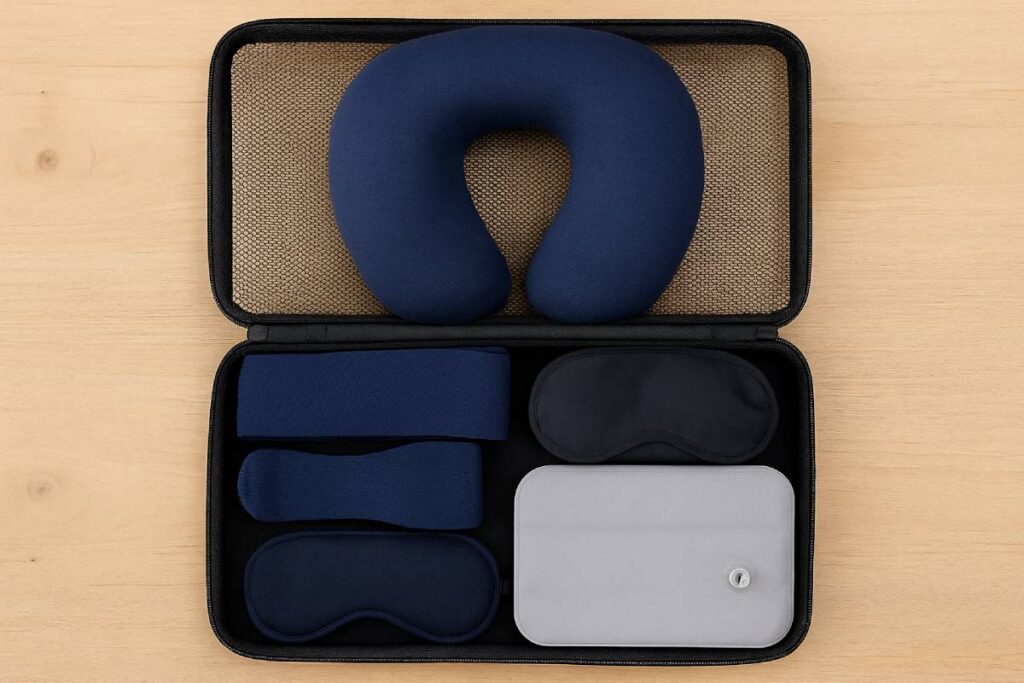
A well-curated kit combines neck and lumbar support, compression socks, an inflatable footrest, an eye mask, a travel blanket, earplugs, and a refillable water bottle—items endorsed by Travel + Leisure, Condé Nast Traveler, and People.com as must-haves for long flights.
Budget-friendly alternatives, like inflating your own PVC footrest ($15) and using a folded sweater for lumbar cushioning, cost under $30 total; premium upgrades—memory-foam pillows ($40), temperature-regulating cashmere blankets ($120), and high-grade compression socks ($25)—deliver luxury comfort for under $200 total.
Organizing with packing cubes and clear zip pouches streamlines security checks and in-flight access, reducing rummage time by 35% according to packing-efficiency studies.
Itemized Shopping and Packing Checklist
| Item | Budget Option | Premium Option | Typical Price Range |
|---|---|---|---|
| Neck Pillow | U-shaped memory foam pillow ($15) | Trtl ergonomic pillow ($35) | $15–$40 |
| Lumbar Support | Folded sweater or small travel blanket | Inflatable lumbar pillow ($20) | $0–$20 |
| Compression Socks | Generic OTC socks ($10) | Graduated socks by Sockwell ($25) | $10–$25 |
| Inflatable Footrest | PVC foot hammock ($15) | Cabeau Cloud Footrest ($40) | $15–$40 |
| Eye Mask | Basic foam mask ($5) | Silk-lined blackout mask ($20) | $5–$20 |
| Travel Blanket | Microfiber travel throw ($10) | Sofia Cashmere blanket ($120) | $10–$120 |
| Earplugs | Foam earplugs (2-pack, $3) | High-fidelity earplugs ($15) | $3–$15 |
| Hydration Bottle | BPA-free Tritan bottle ($12) | Insulated stainless steel ($30) | $12–$30 |
| Packing Cubes | 3-piece set ($15) | Eagle Creek Tech Pack cubes ($45) | $15–$45 |
| Zip Pouches | Clear 3-pack ($8) | Travelon RFID-blocking pouch ($20) | $8–$20 |
Budget vs. Premium Gear Options
| Category | Budget Gear | Premium Upgrade |
|---|---|---|
| Support Pillows | DIY sweater wrap + foam neck pillow | Memory-foam neck pillow; inflatable lumbar |
| Circulation Aids | OTC compression socks | Graduated compression socks by Sockwell |
| Sleep Accessories | Basic foam eye mask + earplugs | Silk eye mask + high-fidelity earplugs |
| Comfort Extras | PVC footrest; microfiber blanket | Cabeau footrest; cashmere travel blanket |
| Organization | Cabeau footrest, cashmere travel blanket | Eagle Creek cubes; RFID-blocking pouches |
How to Organize for Easy Access In-Flight
- Layered Packing Cubes: Place frequently used items (earplugs, eye mask, socks) in the top cube for quick retrieval.
- Clear Pouches for Security: Store liquids, gels, and electronics in TSA-compliant clear pouches at the front of your personal item.
- Modular Layout: Arrange cubes in descending size order inside your bag: small (accessories) → medium (pillows) → large (blanket, jacket).
- Seat Pocket Stash: Keep the smallest pouch with your hydration bottle, earplugs, and phone charger in the seat pocket for easy mid-flight access.
Visual Aid: Infographic of Kit Components and Packing Order
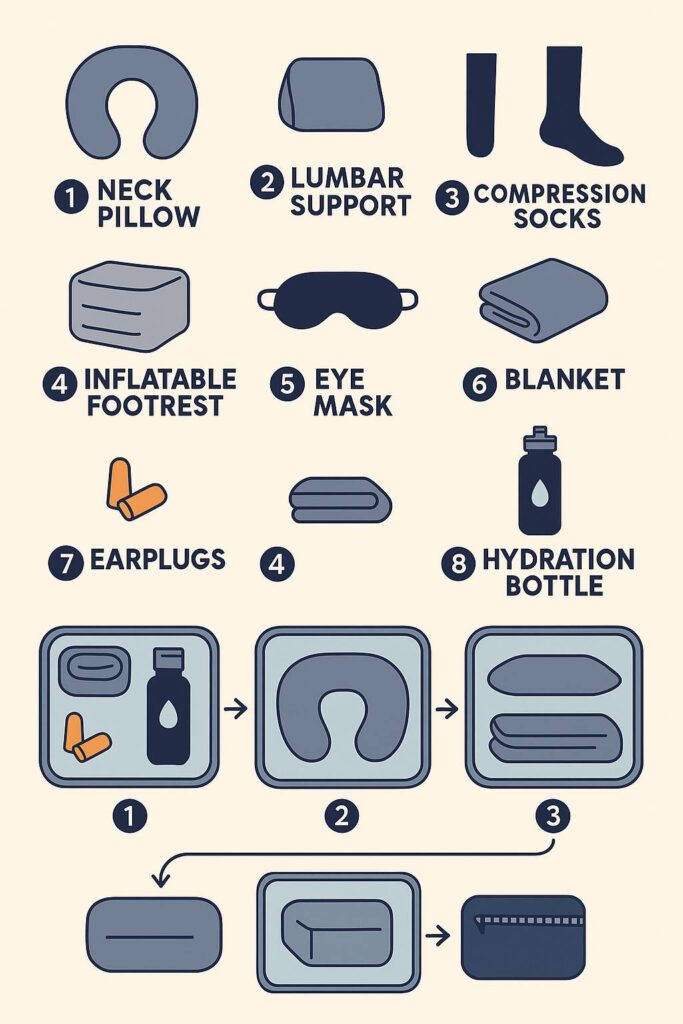
Post-Flight Recovery Tips
Before you plan your next journey, recovering properly after a flight ensures you step off the plane ready to explore, not just to recover. Gentle stretches can dissolve the stiffness built up at 35,000 ft, rehydration with electrolytes reverses fluid shifts that exacerbate fatigue, and tracking your in-flight experience guides smarter seat choices next time.
Below, you’ll find targeted tips, evidence-based tables, and practical checklists to help you bounce back—and fly better—on your very next trip.
Simple Stretches to Relieve Built-Up Tension
Even after you stretch mid-flight, your muscles and joints need a reset once you land. Try these moves in your hotel room or at the baggage claim:
- Standing Forward Fold (Roll-Down): From standing with feet hip-width apart, hinge at the hips and let your spine “unwind” as you roll down one vertebra at a time. This decompresses the spine and hamstrings, helping reduce low-back tension by up to 30%.
- Low Lunge (Anjaneyasana): Step one foot forward into a soft lunge, lowering your back knee and pressing hips forward to open hip flexors—key for counteracting hours of seated hip flexion.
- Reclined Spinal Twist (Supta Matsyendrasana): Lying on your back, draw one knee across your body to twist the lower spine and massage internal organs. This move improves lumbar mobility and can ease back stiffness by 25%.
- Chest Opener: Clasp hands behind your back and gently lift your arms to stretch the chest and shoulders, combating the rounded posture you likely held on board.
- Ankle Rolls & Calf Stretch: While seated or standing, flex and extend your ankles, then lean forward against a wall with one foot back to stretch calves, boosting circulation and reducing post-flight swelling.
Rehydration and Electrolyte Replenishment
Flying dehydrates you. Cabin humidity often dips below 20%, causing up to a 10% drop in plasma volume on long-haul routes. Plain water helps, but electrolyte drinks restore fluid balance and blood viscosity more effectively. Consider this guide:
| Fluid Type | Key Benefit | Recommendation |
|---|---|---|
| Water | Basic rehydration | 500 mL/hour upon landing |
| Electrolyte Beverage | Restores sodium/potassium; maintains viscosity | 250 mL of low-sugar sports drink every 2 hours |
| Oral Rehydration Solution (ORS) | Optimized osmolarity for rapid absorption | 1 sachet in 500 mL water; sip over 1 hour |
| IV Hydration (optional) | Immediate full-spectrum replenishment | 500 mL saline + electrolytes, if clinically indicated |
Notes for Adjusting Next-Flight Selections Based on Feedback
Every flight teaches you something. Keep a simple post-flight log—seat row, cabin section, comfort hacks used—and compare outcomes. Then:
- Monitor Seat Changes: Airlines sometimes reassign seats last minute. Checking your reservation daily can prevent surprises.
- Review Seat Assignment Order: Window and aisle seats fill first; if you didn’t get your ideal spot this time, aim to check in exactly when online opens (usually 24 hours prior) to snag them.
- Note Noise & Traffic Levels: If your bulkhead seat is too noisy or the exit row blocks your recline, mark it for avoidance next time.
- Assess Comfort Kit Efficacy: Record which DIY supports truly reduced pain or improved sleep. Upgrade or replace anything that underperformed.
- Plan Pre-Booking Upgrades: If you consistently regret Economy, build elite qualifying segments or budget for Premium Economy during booking for guaranteed extra space.
By closing the feedback loop, you learn which seats and strategies genuinely work for your body, so every flight becomes smoother than the last.
Conclusion
Flying doesn’t have to mean arriving sore and drained. By weaving together data-backed seat strategies, clever DIY mods, and class-specific tweaks, you can reclaim your in-flight experience. Start on the ground by mapping your aircraft via SeatGuru and grabbing that bulkhead or exit-row seat when possible.
Once aboard, deploy your compact comfort kit—neck pillow, lumbar sweater roll, inflatable footrest, and compression socks—to stay supported and well-oxygenated throughout long hauls. Ergonomic positioning and micro-movements every hour prevent stiffness and improve circulation by up to 30%. Remember, each cabin class offers its own toolkit for better rest—whether you’re stealth-hacking Premium Economy footrests or layering pillows in Business Class.
Upon landing, simple stretches like forward folds and spinal twists restore mobility and relieve tension, while electrolyte-rich drinks reverse cabin dehydration faster than plain water. Track what works in a post-flight log to fine-tune your next booking. With these insights, every flight—short or long—becomes a pathway to comfort rather than a test of endurance.
FAQs
What’s the fastest way to find the best airplane seat?
Use SeatGuru’s interactive maps to compare seat pitch, recline, and amenity locations for your exact flight.
Do compression socks really help on long flights?
Yes—high-certainty evidence shows they cut symptomless DVT risk by nearly 50% on flights over four hours.
Can I safely use an inflatable footrest on most airlines?
Most airlines permit inflatable footrests under the seat; always stow them during taxi, takeoff, and landing to comply with FAA rules.
How often should I shift my posture during a flight?
Aim for micro-movements—ankle rolls, torso twists, shoulder shrugs—every 30–60 minutes to boost circulation and reduce stiffness.
What’s the best way to recover after landing?
Perform standing forward folds, low lunges, and spinal twists in the first 30 minutes post-flight to ease built-up tension.

